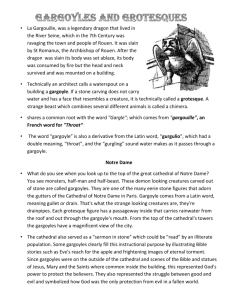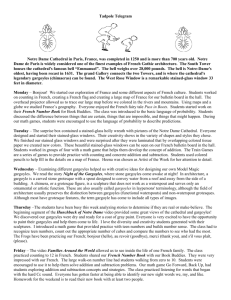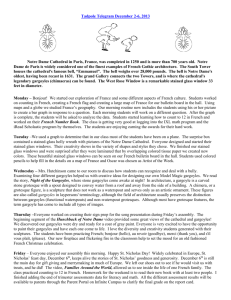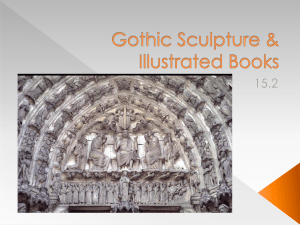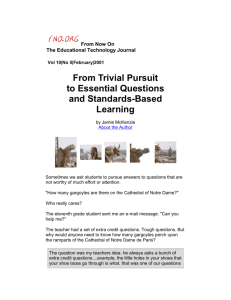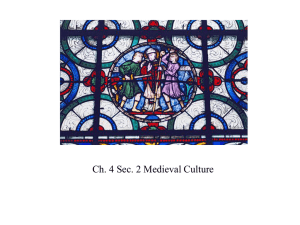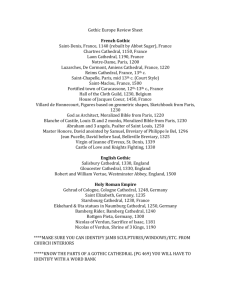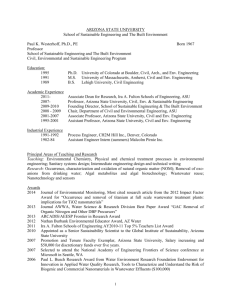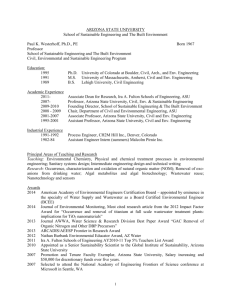Gargoyles: Example of an Excellent Paper
advertisement
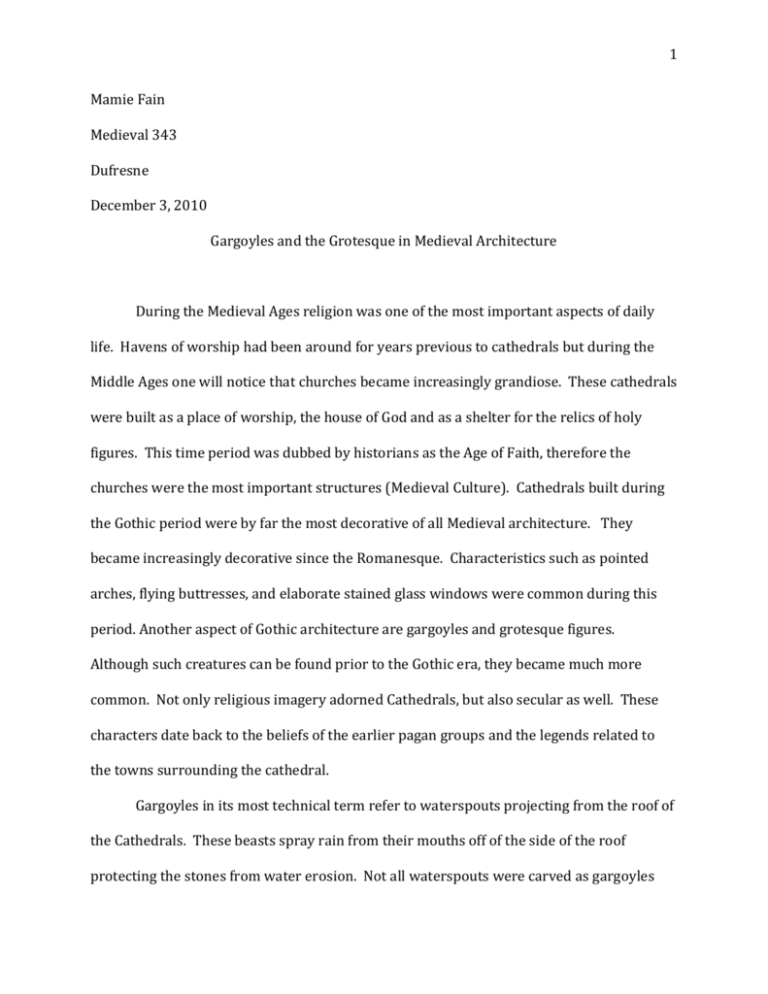
1 Mamie Fain Medieval 343 Dufresne December 3, 2010 Gargoyles and the Grotesque in Medieval Architecture During the Medieval Ages religion was one of the most important aspects of daily life. Havens of worship had been around for years previous to cathedrals but during the Middle Ages one will notice that churches became increasingly grandiose. These cathedrals were built as a place of worship, the house of God and as a shelter for the relics of holy figures. This time period was dubbed by historians as the Age of Faith, therefore the churches were the most important structures (Medieval Culture). Cathedrals built during the Gothic period were by far the most decorative of all Medieval architecture. They became increasingly decorative since the Romanesque. Characteristics such as pointed arches, flying buttresses, and elaborate stained glass windows were common during this period. Another aspect of Gothic architecture are gargoyles and grotesque figures. Although such creatures can be found prior to the Gothic era, they became much more common. Not only religious imagery adorned Cathedrals, but also secular as well. These characters date back to the beliefs of the earlier pagan groups and the legends related to the towns surrounding the cathedral. Gargoyles in its most technical term refer to waterspouts projecting from the roof of the Cathedrals. These beasts spray rain from their mouths off of the side of the roof protecting the stones from water erosion. Not all waterspouts were carved as gargoyles 2 but in the tradition of Gothic decor, they were the preferred architectural touch. The earliest record of a gargoyle like creature was a classical Greek lion on the Acropolis in Athens, dating back to the 4th century (Westerhoff and Stevens). Sometimes the functional benefit of the gargoyles was more of a nuisance. Although such a device is good for the building, the people walking below would have to dash through the pouring water in order to exit or enter the Cathedral, therefore getting drenched by the spouts (Camille 12). As earlier stated, the term gargoyles really only applies to the functional creature, however over time other beasts have been dubbed with the same name. These creatures are more likely known as grotesques or chimeras, and are more so decorative than functional. These type of creatures are not used as rainspouts, but are considered more as protectors of the cathedral. One explanation for the gargoyle is the legend of “La Gargouille.” It described a creature with a long neck, slender jaw and membranous wings, similar to that of a reptile or dragon. This creature ate ships, caused flooding and had a fiery breath. The people of the town would bring the creature a human sacrifice once a year in order to appease it. The individual was usually a criminal. One day the priest decided that he would perform an exorcism on the creature. He subdued the dragon with a victim and took it captive. The animal was killed and burned at the stake, leaving only its head and neck, which was hung on a wall in the town. According to this French legend, this was the model for the gargoyle (Medieval). Both gargoyles and grotesques are used as protectors for the cathedral. Just as the dragonhead from the legend was mounted on a wall to remind and protect the towns people, the fantastic creatures of Cathedral were used for the same reason. These beings portray both animals and human, along with demons. They are 3 considered adornment and yet serve as protectors. It was believe that in order to protect the cathedral from evil, something equally as frightening must be used. They seem to warn the spirits to stay away and take another route. The reasoning behind the energetic vertical thrust of a cathedral is to remind the people to focus upward, keep their eyes toward God. The grotesques and gargoyles seem to be peering down and out at the people. Some of them were a reminder of the hellish consequences of sinning. Some show demons eating humans, symbolizing the punished sinner. The gargoyles who spray water are laborers just as the towns people would have been, and in some way it appears that the creatures were spared from hell but live lives in stone and of labor, frozen in their bearings (Cwrl). Many gargoyles, like those on Notre Dame Paris are energetically leaping from the building with open mouths and wide eyes. This is a common position for gargoyles no matter the cathedral or location. The characteristics of grotesques and gargoyles vary all over Europe. Many have ambiguous genders and are mixtures of several animals in one. Dogs, and lions were frequently used along with grotesque style human faces. The mouths are gargoyles and grotesques were often open, for the functioning creatures, so that the water can escape, but for others it was strictly decorative. The animals appear to be eating or screaming. This is a way to portray the creatures as more threatening. Pagan imagery was also used in figures. Men with entangled foliage usually would have been a symbol of the druids or if the greenery was wrapped around the head it could have been a sign of divinity. Sex was also a common theme, not just fertility but sin. Some of the sexual connotations were stronger than other, for example the Irish Sheela-na Gig is shown as a questionably older lady prying open her exaggerated vulva (Westerhoff). Such an image is hard to imagine 4 being on a church but it was a common pagan image. Other interesting human style figures is the 15th century “wild man” located on the Senlis Cathedral. He is wrapped in hair and his protruding off the side of the wall similar to the functional waterspouts (Camille 134). This figure represents the beast human, perhaps a human nature not regularly addressed. Many animals had disembodied heads. These aspects dated back to the head hunting Celts of the 5th century. They would then worship the heads once severed, similar to the legend of the La Gargouille. Gargoyles and grotesque figures seem to all address that element of fear and interest. They are both considered fantastic and frightening. Not all individuals of the Middle Ages appreciated the use of the grotesque creatures. St. Bernard of Clairvaux wrote "What are these fantastic monsters doing in the cloisters under the very eyes of the brothers as they read? What is the meaning of these unclean monkeys, strange savage lions and monsters? To what purpose are here placed these creatures, half beast, half man? I see several bodies with one head and several heads with one body. Here is a quadruped with a serpent's head, there a fish with a quadruped's head, then again an animal half horse, half goat... Surely if we do not blush for such absurdities we should at least regret what we have spent on them" (Westerhoff). In this quote it seems that he is admitting the interest of the creatures, however he says that they are so decorative and grotesque that they could be distracting to the monks in the cathedrals at the time. St. Bernard did not support extravagant decoration in the church, he believed the monks needed to live simple lives and abstain from such interference. A similar quote was made by Pope Gregory, “Destroy the idol. Purify the temples with holy water. Set relics there, and let them become temples of the true God. So the people will have no need to change their place of concourse, and, where of old they were wont to 5 sacrifice cattle to demons, thither let them continue to resort on the day of the saint to where the Church is dedicated, and slay their beasts, no longer as a sacrifice but for social meal in honor of Him whom they now worship” (Westerhoff). Disturbing and grotesque imagery was not uncommon in the Gothic era. Serpents and distorted figures had been used for years to relate the story of Adam and Eve. Sins were often portrayed on the exterior of the Cathedral. On the portals, the Last Judgment shows sinners without the reward of Heaven. According to Camille’s book Gargoyles of Notre Dame, “During the Middle Ages monsters were kept at a distance…on the edge of maps, and in book margin” (Camille 139). It is logical that they would make their way out onto the nave of a Cathedral, used as a means of protection from evil. Also they acted as a visual for the illiterate of the time; the Cathedral as the refuge from sin and the gargoyles as its protector. It is now difficult to assign a date to the exterior sculptures, as over time weather and war took its toll and many of the figures have been replaced. Some were recreated and others were renovated. Aside from the fact that Cathedrals took many years to build and were destroyed and rebuilt often, therefore the sculptures vary in ages, during the Gothic revival many gargoyles and grotesques were added. Such creatures are still fascinating no matter what date they were constructed, they continued to serve the same purpose in the later centuries as did they in the Middle Ages. 6 Work Cited “Medieval Culture." Creighton University BSCW. Le Moyne College. Web. 01 Dec. 2010. <http://puffin.creighton.edu/museums/archive/gargoyle/cult.html>. Westerhoff, and Stevens. "Gargoyles." Digital Writing and Research Lab. York Minster Visual Introduction to Grotesques. Web. 01 Dec. 2010. <http://www.cwrl.utexas.edu/~bump/oxford/gargoyles.html>. Camille, Michael. The Gargoyles of Notre-Dame: Medievalism and the Monsters of Modernity. Chicago: University of Chicago, 2009. Print. Alston, David. "Gargoyles and Grotesques." JSTOR. Oxford Art Journal, 1978. Web. 29 Nov. 2010. 7 8
